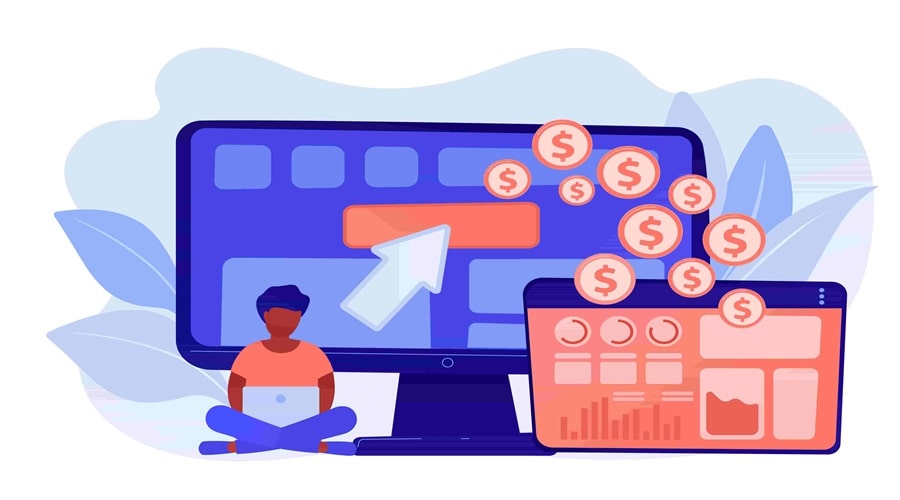
Navigating SaaS Pricing: Models, Strategies, and Psychological Tactics
In the dynamic era of Software as a Service (SaaS), pricing models stand as pivotal determinants of a company’s success. Crafting the right pricing strategy is akin to navigating a maze of options, each promising to unlock revenue potential and drive customer acquisition. SaaS Pricing Models are not just about assigning numbers to products; they encapsulate the essence of value perception, competitive positioning, and revenue optimization. From flat-rate subscriptions to usage-based pricing and everything in between, these models shape the relationship between SaaS providers and their clientele, influencing decisions and driving growth. This exploration delves into the intricacies of SaaS Pricing Models, dissecting their components, assessing their effectiveness, and ultimately guiding businesses toward the most suitable approach for their unique offerings and market dynamics.
What are SaaS Pricing Models?
SaaS pricing models encompass a diverse array of frameworks and strategies devised to establish the pricing structure for software applications delivered via the Internet on a subscription basis. These models intricately detail how customers are billed for the SaaS product, typically through recurrent monthly or annual fees. Unlike conventional software licensing models, SaaS pricing models are meticulously crafted to harmonize with the distinct attributes of the SaaS business model. This includes scalability, which allows for seamless adaptation to varying user demands, continuous updates that ensure customers access the latest features and enhancements without additional costs, and the establishment of reliable recurring revenue streams that bolster long-term financial stability.
Various SaaS pricing models have emerged to cater to different business objectives, customer preferences, and market dynamics. Among the most prevalent are the freemium model, offering basic features for free while charging for premium functionalities; tiered pricing, wherein customers can choose from multiple packages with varying levels of features and pricing; usage-based pricing, where charges are based on the extent of usage or consumption of the software; and value-based pricing, which aligns pricing with the perceived value and benefits derived by customers.
Pricing Models vs. Pricing Strategies:
It’s crucial to recognize the distinction between pricing models and pricing strategies within the SaaS realm. Pricing models serve as the foundational structures dictating how customers are billed for accessing the SaaS product, encompassing formats like subscription-based, usage-based, or freemium models. These models lay the groundwork for revenue generation and customer engagement, providing a fundamental framework for pricing strategies.
Conversely, pricing strategies delve into the specific tactics and methodologies to establish and refine pricing within a chosen model. These strategies are dynamic and adaptable, crafted to optimize revenue generation, enhance market competitiveness, and maximize customer satisfaction. Among the myriad of pricing strategies, several key approaches stand out:
Value-Based Pricing:
This strategy hinges on aligning the price of the SaaS product with the perceived value it delivers to customers. By emphasizing the benefits and outcomes users can expect to achieve, SaaS providers can justify premium pricing and cultivate a sense of value appreciation among their customer base.
Competitive Pricing:
In this approach, SaaS companies analyze and benchmark their pricing against competitors in the market. Businesses can attract price-sensitive customers by strategically positioning their offerings in relation to rival products while maintaining a competitive edge in the industry landscape.
Penetration Pricing:
This strategy involves setting initial prices lower than competitors to penetrate the market swiftly and gain a significant share of customers. Once a foothold is established, prices may gradually be increased to reflect the product’s value proposition and capitalize on customer loyalty and satisfaction.
Dynamic Pricing:
Dynamic pricing entails adjusting prices in real time based on factors such as demand fluctuations, market conditions, and customer behavior. By leveraging data analytics and predictive algorithms, SaaS providers can optimize pricing dynamically to maximize revenue and adapt to evolving market dynamics.
Bundling and Packaging:
Bundling involves offering multiple products or services together as a package at a discounted price, encouraging customers to purchase additional offerings, and increasing overall revenue. On the other hand, packaging involves tiering features and functionalities into distinct bundles to cater to different customer segments and usage scenarios.
Importance of SaaS Pricing—Why Does It Matter?
The importance of SaaS pricing extends beyond mere monetary transactions; it serves as a linchpin for any SaaS business’s overall success and viability. Here’s an expanded look at why SaaS pricing matters:
Customer Acquisition and Retention:
Effective pricing strategies are instrumental in attracting new customers and retaining existing ones. By meticulously aligning pricing with customers’ perceived value and willingness to pay, SaaS companies can cultivate a loyal customer base while enticing new users to engage with their offerings.
Revenue Optimization:
Optimal pricing is essential for maximizing revenue potential while maintaining market competitiveness. Through strategic pricing adjustments and iterative refinement, SaaS companies can ensure they capture the full value of their products and services, enhancing overall profitability.
Product Positioning:
Pricing is pivotal in positioning the SaaS product within the market landscape. It communicates the value proposition and target audience to potential customers, guiding their perceptions and influencing purchasing decisions. A well-defined pricing strategy can differentiate the SaaS offering and create a distinct niche amidst competitors.
Scalability and Growth:
Well-designed pricing models lay the foundation for scalable growth by facilitating efficient resource allocation and revenue forecasting. As SaaS businesses expand their customer base and product offerings, adaptable pricing structures enable them to accommodate evolving market dynamics while maintaining profitability and sustainability.
Competitive Advantage:
Innovative pricing strategies are potent tools for differentiating SaaS companies from their competitors and establishing a unique selling proposition. SaaS providers can carve out a competitive edge and position themselves as market leaders in their respective domains, whether through value-based pricing, creative bundling strategies, or dynamic pricing models.
SaaS Pricing Model Examples:
Examples of SaaS pricing models offer insight into the diverse approaches companies employ to structure their offerings:
Flat-Rate Subscription:
Under this model, customers pay a fixed recurring fee, typically monthly or annual, for unlimited access to the SaaS product. This straightforward approach provides predictability for customers and providers, fostering a stable revenue stream.
Tiered Pricing:
Tiered pricing introduces flexibility by offering different pricing tiers with varying levels of features, usage limits, or the number of users/seats. This allows customers to select the tier that best aligns with their needs and budget while enabling SaaS companies to cater to a broader range of customer segments.
Usage-Based Pricing:
Customers who choose the usage-based pricing model are billed according to how much they actually use the SaaS product, which is typically determined by metrics like storage, bandwidth, and API calls. This pay-as-you-go method provides scalability and cost-effectiveness, especially for users with erratic usage patterns.
Freemium:
This business model allows consumers to test out a SaaS product’s fundamental features without paying upfront by providing a free version. Customers can then upgrade when their needs change by paying for a subscription that offers premium features or advanced capabilities.
Per-User Pricing:
Pricing based on the number of users or seats is common in team collaboration tools or enterprise-level SaaS products. This model enables organizations to scale their usage in line with their team size or organizational growth while providing clarity and pricing transparency.
Pay-Per-Feature:
In this model, customers pay for specific features or modules of the SaaS product, allowing them to customize their subscriptions based on their unique requirements. This granular approach offers flexibility and cost-effectiveness, as customers only pay for the needed features, avoiding unnecessary expenses.
Concurrent User Pricing:
Concurrent user pricing charges customers based on the number of simultaneous users accessing the SaaS product at any time. This model is particularly suitable for applications where multiple users, such as collaborative tools or project management platforms, may access the system concurrently.
Custom Pricing:
Custom pricing involves tailoring the pricing structure to meet individual customers’ or enterprise clients’ specific needs and budgets. This approach allows SaaS companies to accommodate unique requirements, negotiate pricing terms, and foster long-term partnerships with key clients.
Platform as a Service (PaaS) Pricing:
PaaS pricing models differ from traditional SaaS models as they focus on providing a platform for developers to build, deploy, and manage applications. Pricing in PaaS models typically revolves around usage-based metrics such as computing resources, storage, and additional services like databases or middleware.
Infrastructure as a Service (IaaS) Pricing:
IaaS pricing models offer customers access to virtualized computing resources, including servers, storage, and networking infrastructure, on a pay-per-use basis. Pricing is based on resource consumption, storage capacity, and data transfer, providing scalability and cost-efficiency for businesses deploying cloud-based solutions.
SaaS Pricing Strategy Examples:
Value-Based Pricing:
This strategy pegs pricing to the perceived value and benefits the SaaS product delivers to customers. By emphasizing the value proposition and aligning pricing accordingly, companies can justify premium prices and cultivate customer willingness to pay.
Competitive Pricing:
Competitive pricing entails setting prices based on rates offered by direct competitors operating within the same market segment. By benchmarking against competitors, companies can ensure their pricing remains competitive while capturing market share and maximizing revenue potential.
Penetration Pricing:
Penetration pricing involves initially setting prices at a lower level to penetrate the market rapidly and gain a significant share of customers. Once a foothold is established, prices may gradually increase to reflect the product’s value proposition and capitalize on customer loyalty and satisfaction.
Price Skimming:
Price skimming sets high initial prices to capture the maximum revenue from early adopters and customers willing to pay a premium for innovative solutions. Over time, prices are gradually lowered as the market matures and competition intensifies, making the product more accessible to a broader customer base.
Bundling:
Bundling combines multiple SaaS products or features into packages offered at a discounted price compared to purchasing them individually. This strategy encourages customers to opt for higher-tier packages, driving revenue growth while providing added value and convenience.
Dynamic Pricing:
With dynamic pricing, prices are changed in real-time in response to factors like market conditions, consumer segmentation, and variations in demand. Businesses can utilize data analytics and algorithms to take advantage of price possibilities and optimize pricing dynamically to maximize revenue.
Segmented Pricing:
Segmented pricing adjusts pricing strategies to suit various consumer categories based on variables like usage trends, geographic location, or client demographics. By using this strategy, companies can maximize revenue potential while satisfying the varied demands and tastes of their clientele.
Discounts and Promotions:
Offering discounts and promotions, such as introductory offers, seasonal discounts, or volume-based pricing, can incentivize customer acquisition, encourage upsells, and stimulate demand. These temporary pricing tactics help drive short-term revenue growth and attract price-sensitive customers.
Psychological Pricing Hacks for SaaS Companies:
Charm Pricing: Prices ending in “9” or “99” create the illusion of a lower price (e.g., $99 instead of $100).
Psychological pricing hacks are crucial in influencing customer perceptions and behaviors, particularly in the competitive landscape of SaaS. Here’s an expanded look at some psychological pricing strategies commonly employed by SaaS companies:
Charm Pricing:
Charm pricing involves setting prices just below a round number, typically ending in “9” or “99”, to create the illusion of a lower price. For instance, pricing a product at $99 instead of $100 can make it seem more affordable and enticing to potential customers, exploiting the psychological tendency to perceive prices ending in “9” as more appealing.
Decoy Effect:
The decoy effect leverages the principle of relativity by offering a higher-priced option alongside the desired choice to make it appear more attractive and reasonably priced. By introducing a decoy option that is intentionally less appealing, SaaS companies can steer customers toward their preferred pricing tier, effectively influencing purchasing decisions.
Anchoring:
Anchoring involves presenting a higher reference price to anchor customer perceptions and make the actual price seem more reasonable. By showcasing a premium-priced option or highlighting the value of a comparable product, SaaS companies can frame the pricing discussion to favor their offerings, ultimately driving conversions and maximizing revenue.
Subscription Duration Discounts:
Offering discounts for longer subscription durations, such as annual plans, compared to monthly subscriptions, can incentivize customers to commit to extended usage periods. SaaS companies can encourage customers to opt for longer-term commitments by providing cost savings and locking in revenue upfront, enhancing lifetime value and revenue predictability.
Free Trial Periods:
Providing a free trial period allows customers to experience the SaaS product firsthand without any financial commitment, reducing perceived risk and facilitating the decision-making process. By offering a taste of the product’s value and functionality, SaaS companies can alleviate customer apprehensions, increase trial-to-paid conversion rates, and drive long-term adoption and retention.
Limited-Time Offers:
Introducing limited-time offers, such as flash sales or seasonal promotions, creates a sense of urgency and scarcity, prompting customers to act quickly to seize the opportunity. By capitalizing on the FOMO, SaaS companies can stimulate demand, drive immediate conversions, and generate momentum for their offerings.
Price Bundling:
Bundling complementary products or features and offering them at a discounted price can increase perceived value and encourage customers to upgrade to higher-tier packages. By presenting bundled options that deliver added convenience and savings, SaaS companies can upsell and cross-sell effectively, boosting average revenue per user (ARPU) and overall profitability.
How to Choose the Right Pricing Strategy for Your SaaS Company:
Selecting the appropriate pricing strategy for your SaaS company requires a thorough analysis of various factors:
Target Market and Customer Segments:
To begin with, thoroughly understand the consumer categories and target market. Analyze your potential customers’ demographics, needs, preferences, and willingness to pay. Tailoring your pricing strategy to resonate with your target audience’s specific requirements and purchasing behavior is essential for maximizing revenue and customer satisfaction.
Value Proposition and Unique Selling Points:
Evaluate your SaaS product’s unique value proposition and competitive advantages. Identify the core features, functionalities, and benefits that set your offering apart. Your pricing strategy should reflect the value delivered to customers and align with their perception of your product’s worth.
Competitive Landscape:
Analyze your industry’s competitive environment in great detail. Study the pricing strategies employed by direct competitors, including pricing tiers, packaging, and promotional offers. Identify opportunities for differentiation and position your product effectively within the market to capture market share while maintaining profitability.
Cost Structure and Revenue Goals:
Consider your SaaS company’s cost structure, including development, marketing, and operational expenses. Determine your desired profit margins and revenue goals to establish a pricing strategy that balances profitability with competitiveness. Ensure that your pricing model allows you to cover costs while generating sustainable revenue streams.
Growth Stage and Scalability:
Consider your SaaS company’s current growth stage and future scalability plans. Your pricing strategy should be adaptable to accommodate growth and expansion, whether through increasing customer acquisition or expanding into new markets. Ensure that your pricing model scales effectively with your business and can support long-term growth objectives.
Customer Acquisition and Retention Goals:
Evaluate your customer acquisition and retention goals and ensure your pricing strategy aligns with these objectives. Determine how your pricing structure can incentivize customer acquisition, encourage upsells, and minimize churn. Explore freemium models, subscription duration discounts, or loyalty programs to enhance customer retention and lifetime value.
Turn Your SaaS Pricing Strategy into a Business Asset:
Transforming your SaaS pricing strategy into a valuable business asset requires strategic planning and execution. Here’s how you can leverage your pricing strategy to drive business success:
Driving Customer Acquisition:
A well-crafted pricing strategy can be a powerful tool for attracting new customers. By offering competitive pricing that aligns with the perceived value of your SaaS product, you can lower barriers to entry and entice prospects to choose your solution over competitors. Consider incorporating free trials, introductory offers, or discounted pricing tiers to encourage customer acquisition and stimulate trial-to-paid conversions.
Optimizing Revenue Streams:
Optimal pricing models are instrumental in maximizing revenue potential and fueling sustainable growth for your SaaS business. Analyze your market positioning, customer segmentation, and pricing elasticity to identify opportunities for revenue optimization. Implement pricing strategies such as value-based pricing, tiered pricing, or dynamic pricing to capture the full value of your product and enhance overall profitability.
Building Customer Loyalty:
Establishing trust and enduring connections with consumers requires equitable and open pricing methods. Ensure that your pricing is aligned with the value delivered by your SaaS product and that customers perceive it as fair and competitive. Transparent pricing policies instill confidence in your brand and encourage customer loyalty, increasing customer retention and lifetime value.
Enabling Scalability:
Flexible pricing models are crucial for adapting to evolving market conditions and supporting business scalability. As your SaaS company grows, your pricing strategy should be agile enough to accommodate changes in customer needs, market dynamics, and competitive pressures. Consider offering scalable pricing options, such as usage-based pricing or pay-per-feature models, that can scale seamlessly with your business expansion.
Differentiating from Competitors:
Innovative pricing strategies can be a key driver of competitive differentiation in the crowded SaaS landscape. By crafting unique pricing models and value propositions, you can set your SaaS offering apart from competitors and establish a competitive advantage. Explore creative pricing tactics, bundle offerings, or subscription packaging to differentiate your product and attract discerning customers seeking value and innovation.
Enhancing Customer Experience:
Your pricing policy has a significant impact on how the customer interacts with you overall. To ensure a positive purchasing experience, simplify pricing structures, offer transparent billing practices, and provide responsive customer support. By prioritizing customer satisfaction and ease of business, you can enhance customer loyalty, drive repeat purchases, and cultivate brand advocates who contribute to business growth.
Top Tools/Software for SaaS Pricing Models
Price Intelligently:
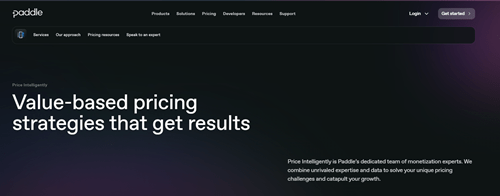
Use of the tool:
Price Intelligently provides data-driven insights and analytics to help SaaS companies optimize their pricing strategies. It offers tools for pricing research, competitive analysis, and price optimization.
Benefits:
Price Intelligently enables SaaS businesses to make informed pricing decisions based on comprehensive market research and analysis. It helps identify pricing opportunities, optimize pricing structures, and maximize revenue potential.
Limitations:
Even though Price Intelligently provides comprehensive pricing analytics, some users can find the learning curve challenging, especially if they have yet to gain experience with data analysis or pricing strategy.
Pricing plan:
Price Intelligently offers customized pricing plans tailored to each business’s specific needs and scale. Pricing is available upon request.
ProfitWell:
Use of the tool:
ProfitWell offers a suite of subscription analytics and pricing tools designed to help SaaS businesses grow and retain their customer base. Its solutions include price optimization, subscription metrics tracking, and churn analysis.
Benefits:
SaaS organizations may enhance revenue, minimize attrition, and optimize subscription prices by utilizing ProfitWell’s actionable insights and data. Its user-friendly interface and reporting features make monitoring pricing performance and tracking important indicators simple.
Limitations:
While ProfitWell offers comprehensive subscription analytics, some users may find the platform’s interface overwhelming, particularly for smaller businesses with limited resources.
Pricing plan:
ProfitWell offers free and paid subscription plans, with pricing based on the features and required level of support.
Zuora:
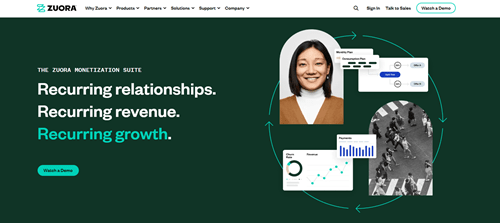
Use of the tool:
Zuora is a leading subscription management platform that enables SaaS companies to design, launch, and manage subscription-based pricing models. It offers tools for pricing experimentation, subscription billing, and revenue recognition.
Benefits:
Zuora streamlines subscription management processes and allows SaaS companies to experiment with different pricing models and subscription plans. Its robust billing and invoicing features help ensure accurate revenue recognition and compliance.
Limitations:
Zuora’s extensive feature set may be more than what smaller businesses need, leading to complexity and potentially higher costs for implementation and maintenance.
Pricing plan:
Zuora offers a range of pricing plans tailored to each business’s size and needs, and pricing is available upon request.
Chargify:
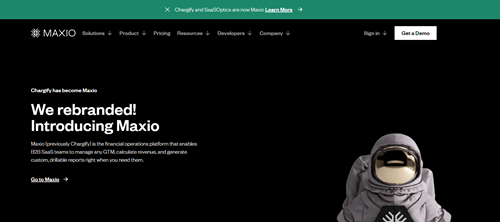
Use of the tool:
SaaS companies can automate their subscription billing procedures and improve their pricing strategies with the aid of Chargify, a platform for revenue management and subscription billing. Features like tiered pricing, dynamic pricing, and subscription lifecycle management are available.
Benefits:
Chargify simplifies subscription billing operations and provides SaaS companies with the tools to implement flexible pricing models and optimize revenue streams. Its intuitive interface and customizable billing rules make it easy to manage complex pricing structures.
Limitations:
Chargify’s pricing may be prohibitive for smaller businesses with limited budgets, and some users may find the platform’s reporting and analytics capabilities need improvement compared to more specialized pricing tools.
Pricing plan:
Chargify offers tiered pricing plans based on the volume of subscriptions and features required, with pricing starting at a monthly subscription fee.
Pricefx:
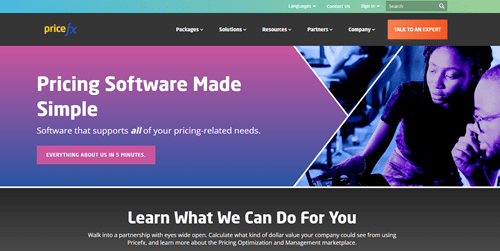
Use of the tool:
Pricefx is a cloud-based pricing optimization platform that provides SaaS companies with advanced pricing analytics and optimization tools. It offers features such as price segmentation, price simulation, and price optimization algorithms.
Benefits:
Pricefx empowers SaaS businesses to make data-driven pricing decisions and optimize pricing strategies to maximize revenue and profitability. Its powerful analytics and simulation tools help identify pricing opportunities and forecast the impact of pricing changes.
Limitations:
Pricefx’s advanced features may require a significant investment of time and resources to leverage fully, and some users may need help with the platform’s interface.
Pricing plan:
Pricefx offers customized pricing plans tailored to each business’s needs and scale, with pricing available upon request.
FAQs:
What is the most common SaaS pricing model?
The most common SaaS pricing model is the flat-rate subscription model, where customers pay a fixed recurring fee for access to the SaaS product. This model offers simplicity and predictability for both customers and providers, fostering a stable revenue stream. It’s widely adopted across various SaaS industries due to its ease of implementation and alignment with the recurring revenue model.
How can I determine the right pricing for my SaaS product?
Your SaaS product’s pricing must be carefully considered based on several variables. Consider your product’s value proposition, target market’s traits and requirements, competitive environment, cost structure, and revenue targets. To gain insights and adjust your price strategy accordingly, conduct in-depth market research, assess client willingness to pay, and test various pricing strategies through A/B testing or pilot programs.
Is it better to offer monthly or annual subscriptions?
Both monthly and annual subscription options have advantages and cater to different customer preferences. Monthly subscriptions provide flexibility and lower barriers to entry, allowing customers to commit on a short-term basis. On the other hand, annual subscriptions often offer discounts and provide revenue forecasting predictability for customers and providers. To appeal to a broader customer base, many SaaS companies offer both options to accommodate varying needs and preferences.
What is the difference between freemium and free trial pricing models?
The freemium model offers a permanently free version of the SaaS product with limited features, enticing users to upgrade to a paid subscription for access to premium functionalities. In contrast, a free trial model provides full access to the SaaS product for a limited time, typically ranging from a few days to a month, allowing users to experience its full capabilities before deciding whether to subscribe. While both models aim to drive conversions, they differ in their approach to offering initial access to the product.
How often should I reevaluate and adjust my SaaS pricing?
Regularly reviewing and adjusting your SaaS pricing strategy is essential to staying competitive and responsive to market dynamics. Aim to conduct pricing reviews annually or bi-annually, considering changes in customer preferences, competitive offerings, market trends, and business goals. Additionally, solicit customer feedback through surveys or interviews to understand their evolving needs and perceptions of value, informing your pricing adjustments accordingly.
Can I charge differently for certain consumer segments?
In the SaaS sector, offering various pricing tiers or customized plans for different consumer categories is standard practice. Customized pricing alternatives are necessary since individual users, small businesses, and enterprises often have different needs, usage patterns, and budgets. You may optimize your revenue potential and provide superior service to various consumer segments by segmenting your customer base and providing price options that correspond with their unique needs and willingness to pay.
Conclusion:
Pricing models and strategies are critical to growth, profitability, and long-term success in the ever-changing SaaS industry. SaaS organizations can maximize the value of their offerings by comprehending the many price models, utilizing psychological pricing hacks, and matching pricing strategies to consumer demands and company objectives. Maintaining competitiveness, drawing in and keeping consumers, and eventually transforming pricing into a potent corporate tool that supports long-term expansion and income creation depends on the constant assessment, testing, and improvement of pricing tactics.




